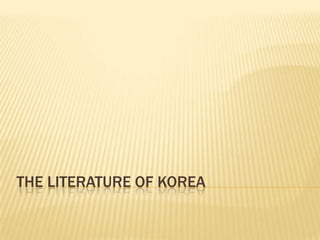
The literature of korea
- 1. THE LITERATURE OF KOREA
- 2. ANCIENT KOREA MODERN KOREA PAST AND PRESENT
- 3. FACTS AND FIGURES (SOUTH KOREA) Area: 99, 270 sq. km Population: 44, 056, 000 Capital: Seoul Other Major City: Pusan Official Language: Korean Main Religions: Buddhism, Christianity Currency: Won Government: Multi-party republic
- 4. NORTH KOREANS SOUTH KOREANS THE KOREANS
- 6. Korea was founded in 2333 BC by a mighty hero named Tangun. Recorded history began independent kingdom at Pyongyang. Chinese rule lasted until the 7th century AD when three independent kingdoms arose in Korea. Korea became a united nation for the first time under Wang Kien, a Korean patriot, who led a revolution in 918 and destroyed the Silla rule in 935. Wang named the country Koryu from which its present name was derived. His descendants ruled until 1392. After a brief invasion by the Mongols,Korea was ruledby the Yi Dynasty (1392-1910) which established the capital at Seoul, introduced Chinese ways, and proclaimed Confucianism as the state religion. The first century of the Yi era was Korea’s Golden Age of civilization. Koreans invented printing, a phonetic alphabet, fostered literature and scholarships, and granted education to the masses.
- 7. The Tangun Myth CREATION MYTH
- 8. The story goes that a Heavenly Prince, Hwangun looked down at earth and desired to possess it and rule over mankind. His father, the Ruler of Heaven, Hwanin knew that his son would bring happiness to human beings and, looking at the earth, chose Mount Taebak as a suitable place for his son to go to earth. Hwangun arrives beneath a sandalwood tree where he creates a holy city. He brings with him three heavenly seals, somewhat mysterious in nature, and 3000 loyal subjects from heaven, which are possibly spirits. In addition, Hwangun brought three ministers, the Earl of Wind, the Master of Rain, and the Master of Clouds. Different accounts of the myth tell that Hwangun either taught or took charge of 360 areas of responsibility, like agriculture and medicine. The story moves now to a bear and a tiger, both desiring to become human beings. Set the task of shunning sunlight and eating only the food given to them by Hwangun (some mugwort and twenty cloves of garlic), the bear succeeds in earning Hwangun’s approval while the tiger fails to fast, fleeing into the forest. The bear becomes a beautiful woman, Ungyo (bear woman) and becomes the wife of Hwangun. Their son is Tangun, the King of Sandalwood. Tangun becomes the first king of Korea, calling his country choson and ruling for 1500 years. After this time he retreats to Taebak-san to become a mountain god.
- 12. KORYO CELADON
- 15. SANDAE (MASK PLAY OF KOREA)
- 16. PROMINENT FIGURES OF KOREA
- 17. HAN YONG-UN
- 18. YUN SON-DO He was born in Seoul, in what is now South Korea. He achieved early success as a government official, but his straightforward character made enemies at court and he was banished for imprudent criticism of those in power. Thirteen years later he returned to become tutor to the royal princes but was later banished again. He spent most of his 85 years in his rustic country home, contemplating the nature of life, teaching and writing poetry. Yun is considered the greatest master in the history of Korean literature.His most famous composition is The Fisherman's Calendar a cycle of forty seasonal sijo. In both Chinese and Korean classical poetry, the fisherman symbolized a wise man who lives simply and naturally. In art, the fisherman appeared almost invariably in one of the most common genres of Asian water colors: sets of four paintings, one for each season of the year. Yun Seondo wove both traditions into The Fisherman's Calendar. It is the longest and most ambitious sijo cycle attempted during the classical period
- 19. YUN TU-SO (b Haenam, South Cholla Province, 20 May 1668; d Haenam, 26 Dec 1715). His eclectic output bridged the transition between painting of the mid-Choson and late Choson periods. Learned in Confucian classics, military strategy, geography and astronomy, he passed the initial state examination (chinsa) in 1693 but returned to Haenam in 1713 without acquiring office. He was aligned with the out- of-power Southerners (Namin), advocates of sirhak (‘practical learning’) and sohak (‘Western learning’). He studied calligraphy with Yi So (1662–1723) and painted as a hobby.
- 20. LEE KWANG-SU
- 21. YI SANG HWA `Does spring come to this land no more our own, to these stripped fields? Bathed in the sun I walk as if in a dream along a lane that cuts across paddy fields like parted hair to where the blue sky and the green field meet. Mute heaven and silent fields, I do not feel I have come here alone; tell me if I am driven by you or by some hidden force… ''
